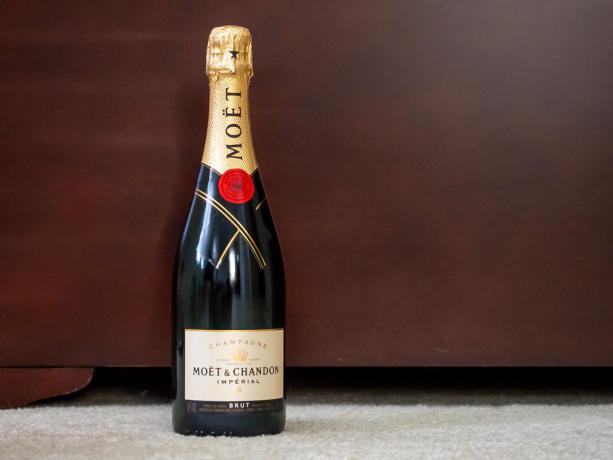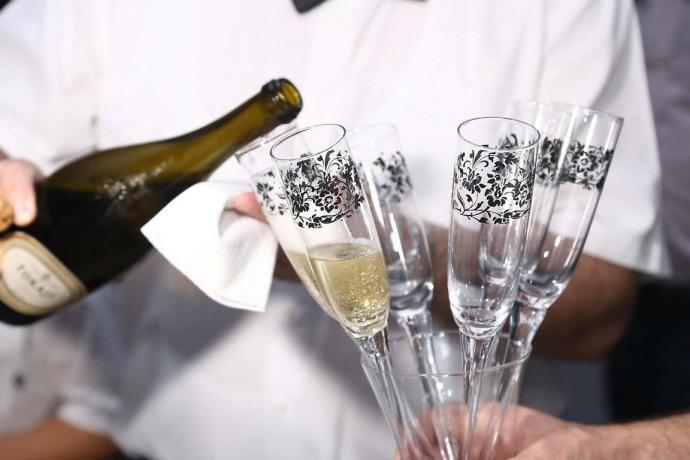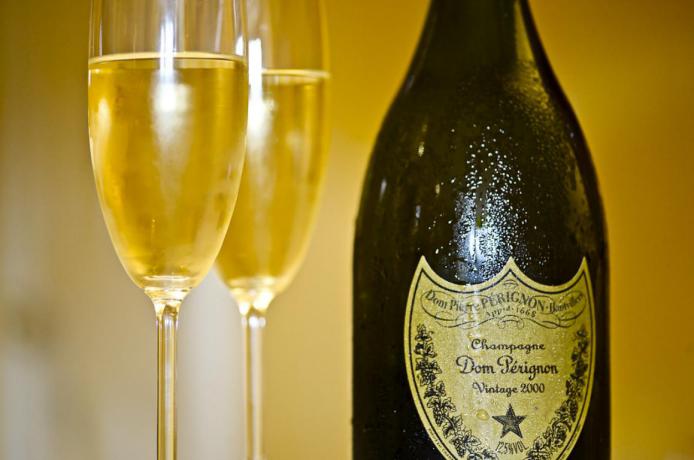Champagne is a sparkling wine often associated with celebrations and special occasions. It is made from specific grape varieties and undergoes a second fermentation process in the bottle to create its signature bubbles.
One question that often comes up regarding this wine is: How much alcohol is in champagne? This article will explore its alcohol content and some factors that can affect it. Let’s scroll down!
What Is Champagne Made Of?
Champagne is made from a combination of several grape varieties: Chardonnay, Pinot Meunier, and Pinot Noir.
The production of champagne involves several stages. After the farmers harvest the grapes, they press them to extract the juice. And then they ferment it.
The farmers then bottle the beverage with additional yeast and sugar, which triggers a second fermentation in the container. During this process, carbon dioxide appears, which creates bubbles.
The winemakers then age this beverage for at least 15 months. During this time, it will develop its unique flavor and aroma.
Several factors can significantly affect the quality of champagne, such as:
- The quality of the grapes
- The methods used in production
- The aging process
- The region’s climate, soil, and topography

Overview of champagne
How Much Alcohol Is In Champagne?
On average, champagne typically has an alcohol content of around 12%. Yet, this concentration can vary between 10-12.5%, depending on some factors.
It is worth noting that some champagne producers may create champagne with higher alcohol content, but it’s less common.
This wine’s alcohol content may vary depending on a few factors. Firstly, the grape variety used can impact the alcohol percentage.
As shared earlier, this wine is made from three main grape varieties: Chardonnay, Pinot Noir, and Pinot Meunier.
Chardonnay produces champagne with a lower alcohol concentration, while Pinot Noir and Pinot Meunier can create champagne with a higher alcohol percentage.
[display-posts id=”287″ image_size=”thumbnail” posts_per_page=”1″]
The region is another factor affecting this wine’s alcohol content. Champagne is a region in France that has strict regulations on winemaking.
The region’s cool climate can produce grapes with lower sugar content, producing a lower alcohol percentage in the finished wine.
However, some manufacturers may add sugar to the beverage during the second fermentation process, which can increase the alcohol concentration.
Finally, the length of time that champagne is aged can also affect its alcohol content.
This wine aged longer tends to have a higher alcohol percentage than younger champagne.

The average alcohol content
Do All Champagnes Contain Alcohol?
While most champagnes contain alcohol, some alcohol-free versions are available. These are often called “sparkling juices” or “sparkling ciders.”
They are made using similar production methods as traditional types but have the alcohol removed through vacuum distillation.
Non-alcoholic champagnes are an excellent option for those who want to enjoy the taste and bubbles of champagne without the alcohol content.
[display-posts id=”614″ image_size=”thumbnail” posts_per_page=”1″]
Can Champagne Get You Drunk?
Champagne is a sparkling wine type from France’s Champagne region. Farmers use a blend of grapes to produce it.
As mentioned above, this wine typically has an alcohol content of 12%, similar to most types. However, some types can have a higher alcohol content of up to 14%.
Like any alcoholic beverage, this option can get you drunk if consumed in large quantities.
The amount it takes to get drunk will vary from person to person based on factors, like body weight and tolerance.
On average, it takes about 3 – 4 glasses to reach the legal limit of intoxication.
Drinking too much can adversely affect overall health. It may impair judgment, coordination, and reaction time.
It can also lead to dehydration and nausea. This beverage contains sugar and causes a hangover the next day.
Is Champagne Stronger Than Other Alcohol?
The alcohol content in champagne and other drinks is different, as shown below:
Wine
Champagne has a higher alcohol content than most wines. Its average alcohol by volume (ABV) is around 12%.
That’s due to the added sugar and the second fermentation process that occurs during champagne production, which increases the alcohol content.
Meanwhile, most wine has an ABV of around 11%. Hence, champagne is slightly stronger than wine.
Vodka
Unlike wine, vodka is a distilled spirit made from grains or potatoes.
Vodka has a higher ABV than champagne. Its ABV is from 35% to 50%. Thus, vodka is much stronger than its counterpart.
[display-posts id=”160″ image_size=”thumbnail” posts_per_page=”1″]
Sparkling Wine
Sparkling wine is similar to champagne because it is carbonated. However, farmers use different grape varieties and fermentation processes.
Generally, the average ABV of sparkling wine is around. Hence, it’s slightly lower than champagne.
Thus, champagne is slightly stronger than sparkling wine regarding alcohol content.
Beer
Most beers have an ABV of 5%. It’s much lower than the alcohol content of champagne. It means champagne is significantly stronger than beer in terms of alcohol content.

Champagne and other types
How To Measure Alcohol In Champagne?
Measuring the alcohol content in champagne is vital for your health and safety.
Using a Hydrometer
A hydrometer is among the most common methods to measure the ABV of champagne. It’s a device that measures the specific gravity of a liquid. Specific gravity is the ratio of a liquid’s density to water’s.
To calculate the champagne’s ABV, take a sample and measure its specific gravity using this device.
Then, it would be best to compare the specific gravity to a chart that will tell you the alcohol content of the wine.
[display-posts id=”641″ image_size=”thumbnail” posts_per_page=”1″]
Using a Refractometer
Another way to measure the alcohol concentration in this wine is by using a refractometer. It is a device that measures the refractive index of a liquid.
The refractive index measures how much a light ray is bent when it passes through a liquid.
To measure this wine’s ABV with this device, you also need to take a sample and place it on the refractometer.
The refractometer will measure the refractive index of the wine. You can use a chart to determine its ABV.
In A Nutshell
Champagne contains around 12% alcohol on average, but it can vary depending on the brand and type.
It may affect your overall health, so it is crucial to drink responsibly. By following the recommended guidelines for alcohol consumption, you can enjoy this wine without risking your health.


